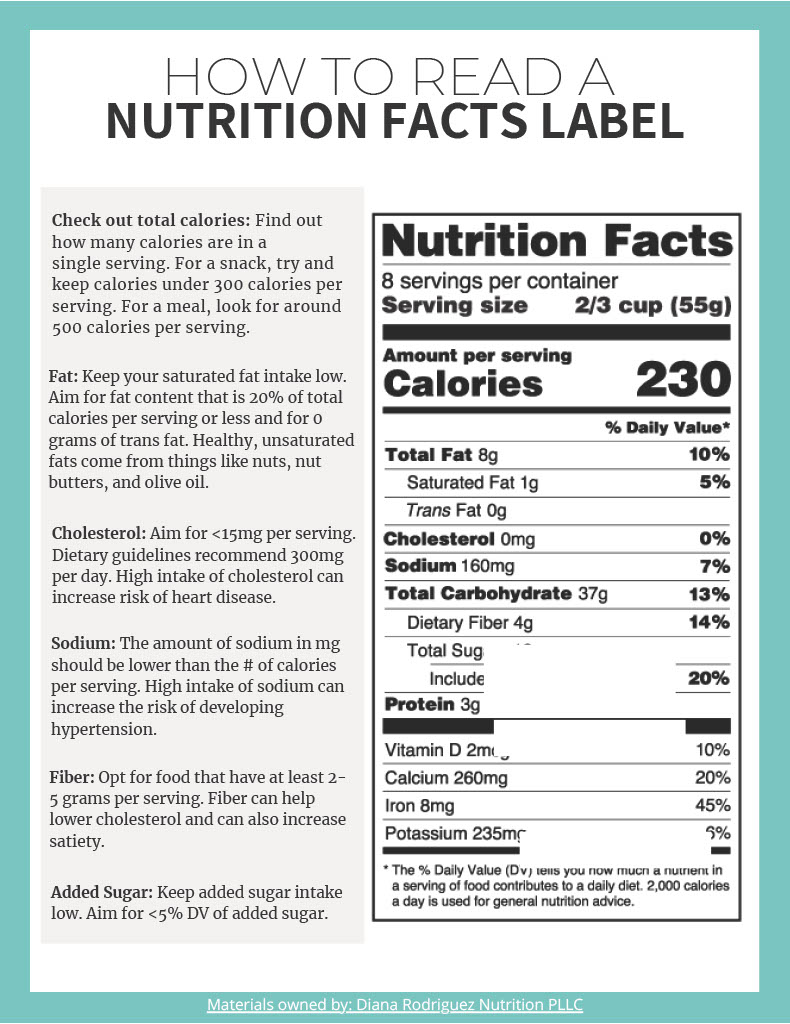Nutrition facts labels can look confusing! However, there are a few key numbers to look at that can help you determine if what you are looking at can help you reach your goals. Let’s get right into it!
How To Properly Read the Nutrition Facts Label

Step 1: At the top of any nutrition facts label, you will notice the serving size. It is important to take note of this because the rest of the values on the label represent the amount of nutrients in just that amount. You will also notice the servings per container, which can help you better understand how big or small a serving size is.
Step 2: The larger number on the label will be the calories. Calories are essential for weight loss or muscle gain. The calories per serving represent the amount of energy that a food item provides. If you are trying to lose weight, keep snacks under 300 calories per serving and meals around 500 calories.
Step 3: Next up on the nutrition facts label will be fat. The label will list both saturated and unsaturated fat. Healthy, unsaturatedfats come from nuts, nut butter, seeds, and olive oil. Try and keep fat content less than 20% of calories per serving or less andlook for items that have 0 grams of trans fat.
Step 4: You will also see cholesterol listed on the nutrition facts label. Dietary guidelines recommend 300mg of cholesterol or lessper day, as a high intake of cholesterol can increase the risk of heart disease. You should aim for <15mg per serving.
Step 5: Next, you will see sodium, which is another word for salt. A rule of thumb is that the amount of sodium in milligrams should be lower than the number of calories per serving. Keeping sodium intake low can decrease the risk of developing high blood pressure. Things like canned soups and canned vegetables may be high in sodium, so look for reduced-sodium options.
Step 7: A little lower down, you will find total carbohydrates, dietary fiber, and added sugars. Total carbohydrates are all carbs in the food, including dietary fiber, total sugars, and added sugars.
An important nutrient I highly recommend start paying attention to is dietary fiber. On average, American adults eat roughly 1-15 grams of total fiber per day, while the USDA’s adequate intake amount for adults is 25 grams for women and 38 grams for men! Fiber is a type of indigestible carbohydrate that increases satiety, reduces bad cholesterol, and is beneficial for digestion. Opt for foods with at least 2-5 grams of fiber per serving. Foods high in fiber include fruits, vegetables, and whole grains.
Below the dietary fiber, you will notice the total sugars and added sugar listed on the label. Total Sugars include sugars naturally present in many foods, like the sugar in milk and fruit, INCLUDING any added sugars that may be present in the product. Added Sugars on the Nutrition Facts label include sugars added during processing, like corn syrup and table sugar. Try and keep added sugar intake low by aiming for <5% daily value of added sugar.
Step 8: The % Daily Value (% DV) is the percent daily value for each nutrient in a food serving. This number shows how much of that nutrient is in one food serving.
A quick guide to %DV
- 5% DV or less of a nutrient per serving is considered low
- 20% DV or more of a nutrient per serving is considered high
Here are a few tips to keep in mind when shopping for better food options:
Fat-free foods do not always mean healthy or healthier. Let me explain. If you are deciding between a fat-free or full-fat food item, go with the full-fat or low-fat. The reason is that some nutrients are needed for your body to absorb fat better. Some vitamins that need fat include vitamins A, D, E, and K, which are your fat-soluble vitamins. For example, when you choose fat-free dairy, your body will not absorb vitamin D well. Therefore, food options with some fat, especially when they naturally come with fat, are usually the better choice. Also, having fat in food provides energy and satiety, which help support your goals. Another tip is to chooce foods without added sugars as often as possible. Usually, highly processed foods contain added sugars and are high in sodium. With everything, moderation is key, and this is not to say you cannot enjoy processed foods here and there (I mean, who doesn’t love a cookie or two), but it is about being mindful of how often you are eating those foods.
Written by Julia Palace, Dietetics Student at the University of Pittsburgh
Reviewed by Diana Rodriguez, MS, RD, CDN


